Related Research Articles
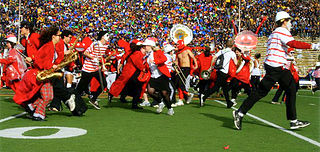
The Leland Stanford Junior University Marching Band (LSJUMB) is the student marching band representing Stanford University and its athletic teams. Billing itself as "The World's Largest Rock and Roll Band," the Stanford Band performs at sporting events, student activities, and other functions. The Stanford Tree is the band's mascot.
Gordon Percival Septimus Jacob CBE was an English composer and teacher. He was a professor at the Royal College of Music in London from 1924 until his retirement in 1966, and published four books and many articles about music. As a composer he was prolific: the list of his works totals more than 700, mostly compositions of his own, but a substantial minority of orchestrations and arrangements of other composers' works. Those whose music he orchestrated range from William Byrd to Edward Elgar to Noël Coward.

The University of California Marching Band, usually shortened to Cal Band, is the marching band for the University of California, Berkeley. While it is administered under the auspices of the university, the Cal Band is almost completely student-run and represents Cal at sporting events and other social gatherings. The name of the band is officially "The University of California Band" according to the constitution, but is typically called "The University of California Marching Band" or "The Cal Band". When the band marches out of Memorial Stadium's North Tunnel for football pre-games, it is referred to as "The Pacesetter of College Marching Bands, the Pride of California".
Douglas Yeo is an American bass trombonist who played in the Boston Symphony Orchestra from 1985 to 2012, where he held the John Moors Cabot Bass Trombone Chair. He was also on the faculty of the New England Conservatory. In 2012 he retired from the BSO and accepted a position as professor of trombone at the Arizona State University School of Music, a position he held until 2016. In 2019, he was appointed to the faculty of Wheaton College (Illinois).
John Marcellus is a trombone musician and teacher. He was Professor of Trombone at the Eastman School of Music of the University of Rochester, and past Chair of the Woodwind, Brass, and Percussion Department. In addition to his trombone teaching responsibilities at Eastman, Dr. Marcellus was the conductor of the Eastman Trombone Choir, Eastman Bionic Bones, and the trombonist with the Eastman Brass. Dr. Marcellus joined the faculty of the Eastman School in 1978, and was named the Kilbourn Professor from 1982-83. He succeeded the trombonist and teacher, Emory Remington, who served as Professor of Trombone at Eastman close to 50 years. Professor Marcellus retired in 2014 after 36 years at Eastman.
The Livermore-Amador Symphony is a local symphony orchestra composed of musicians from the Tri-Valley in the San Francisco Bay Area, United States.
"Victory for MSU", formerly "MSU Fight Song", is the official fight song of Michigan State University. It was created in early 1915, when MSU was known as Michigan Agricultural College (M.A.C.). An MSU cheerleader, Francis Irving Lankey, along with lyricist Arthur Sayles, created the song. With several changes noted below, the school has used the same song ever since. The MSU Fight Song is played at all university sporting events and is frequently sung by students and alumni.

The Harvard University Band (HUB) is the official student band of Harvard University. The Harvard Wind Ensemble, the Harvard Summer Pops Band, and the Harvard Jazz Bands also fall under the umbrella organization of HUB. Currently, the band plays for all football games as well as home men's and women's ice hockey games. Occasionally it plays at men's and women's basketball games. The uniform for both football games and other formal appearances consists of a crimson wool HUB blazer worn over a white shirt with a black HUB logo tie, black pants, and black shoes. In the early days of the Band, white sailor hats and khaki pants were worn. For hockey games, the band wears a custom Harvard Band hockey jersey, modeled after the home jerseys for men's hockey, which features images of Bertha on the sleeves. Band alumni, known as crusties, maintain strong ties to the HUB, sometimes continuing to act as regular members well after graduating from the university. Illegitimum non carborundum (INC) is the HUB motto. Written correspondence from HUB or HUB members is frequently signed with INC.
Warren Benson was an American composer. His compositions consist mostly of music for wind instruments and percussion. His most notable piece is titled The Leaves Are Falling (1964).

Formed in 1845, the Holy Cross Goodtime Marching Band is one of the oldest organizations at The College of the Holy Cross in Worcester, Massachusetts, USA, and one of the oldest college bands in the United States. The Crusaders Marching Band first began performing at football games in 1910 and the band's role has expanded significantly since to include other athletic appearances, performing at all home football games, selected away games, in exhibition at high school band competitions, and at various events throughout the country. In the spring, the marching band converts into the Holy Cross Crusader Pep Band and plays at all home basketball games, and travels with the teams to the NCAA tournament. The Marching Band performs at Fitton Field while the Pep Band plays in the Hart Center.

The University of Wisconsin Marching Band is the marching band for the University of Wisconsin–Madison. It was formed in the fall of 1885 to support the university military battalion. Today, it has grown to about 300 members and performs at all home Badger football games. They are known for their intense and athletic high knee “stop at the top” marching style.

William John Bell was the premier player and teacher of the tuba in America during the first half of the 20th century. In 1921, he joined the band of John Philip Sousa, and from 1924 to 1937 he served as Principal Tuba with the Cincinnati Symphony Orchestra. In 1937 General Electric's David Sarnoff invited conductor Arturo Toscanini to select personnel for The NBC Symphony Orchestra. William Bell was the third musician selected by Toscanini, after his concertmaster Mischa Mischakoff and principal oboe Philip Ghignatti.
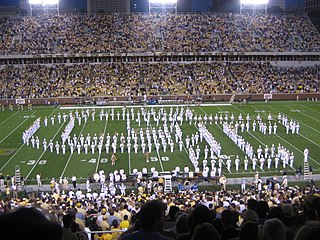
The Georgia Tech Yellow Jacket Marching Band is the official marching band of the Georgia Institute of Technology. Founded in 1908 by a group of 14 students, the Georgia Tech Band is one of the school's oldest student organizations.

The Band of the Fighting Irish is the marching band of the University of Notre Dame. Over 300 members of the band represent nearly every field of study, and include students from across the United States as well as from overseas. The Band of the Fighting Irish is composed of students from the University of Notre Dame, Saint Mary's College, and Holy Cross College. Founded in 1845, it is the oldest university marching band.
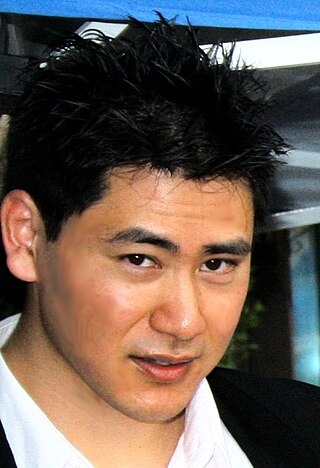
Ray Arthur Wang, born Raymond Wang, is an American independent filmmaker.
Leonard Tan is a trinational-based, Singaporean music director, conductor, tubist, violinist, and music educator at scholastic, collegiate, conservatory, and professional levels
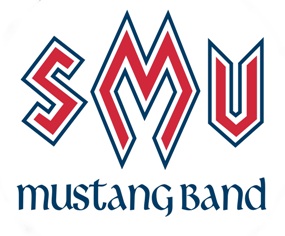
The Southern Methodist University Mustang Band, known as the "Best Dressed Band in the Land" because of its 32 unique uniforms, is the marching band of Southern Methodist University. Long known as “the Hub of SMU spirit,” the 80 member band represents the University at football games, produces the Pigskin Revue during Homecoming, and performs at special University- and community-related events. Founded in 1917, the Mustang Band is currently under the direction of Director Charles Aguillon, Assistant Director Tommy Tucker, and drumline instructor Jon Lee.
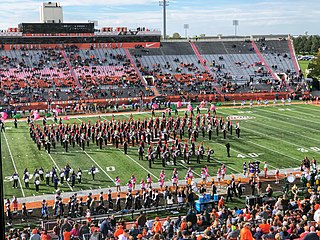
The Falcon Marching Band, known also as the FMB, is the marching band of Bowling Green State University. It features a symphonic sound and chair step marching. Under the direction of Jonathan “Jon” Waters, marching band is the largest student organization on campus. The band performs at all home football games, which are hosted in Doyt Perry Stadium as well as other various university functions.
Leonard Vincent Falcone (Fal-CONE-ee) was an Italian-American musician, conductor, arranger, lecturer, and educator. He was well known as a virtuoso on the baritone horn, having extensively performed, written, and educated on the instrument. Falcone was best known as Director of Bands at Michigan State University from 1927 through 1967. During Falcone's tenure, the Spartan Marching Band expanded from a small ROTC auxiliary band to a large nationally known Big Ten marching band. Scholarship endowments at MSU and Blue Lake Fine Arts Camp were established in his honor, as was the Leonard Falcone International Tuba and Euphonium Festival.
Greg Danner is a contemporary American composer, educator, and professional musician. He is currently the composer-in-residence and professor at Tennessee Tech in Cookeville, Tennessee. He is the 2010 Composer's Guild Grand Prize winner.
References
- ↑ Scott, Cameron; Kasabian, Kim. "Stanford music professor Arthur P. Barnes dies at 93 | Stanford School of Humanities and Sciences". humsci.stanford.edu. Retrieved 2024-06-12.
- ↑ Kasabian, Kim (April 25, 2024). "Stanford music professor Arthur P. Barnes dies at 93 | Stanford School of Humanities and Sciences".
- 1 2 3 4 5 6 7 Johnston, Theresa (March–April 1997), The Greatest Hits of Arthur P. Barnes, Stanford Magazine.
- ↑ Scott, Cameron; Kasabian, Kim. "Stanford music professor Arthur P. Barnes dies at 93 | Stanford School of Humanities and Sciences". humsci.stanford.edu. Retrieved 2024-06-12.
- ↑ Livermore-Amador Symphony History Profile Archived March 29, 2009, at the Wayback Machine , retrieved 2009-04-08.
- ↑ "Farm Report", Stanford Magazine, July–August 2000.
- ↑ "Alumni raise $1.5 million to endow band director position", Stanford Online Report, April 19, 2000.
- ↑ "Stanford Conductor Lays Down His Baton: Director Encouraged Band's Famed Antics", San Jose Mercury News , June 1, 1997.
- ↑ Ferris, Eric (2000), Inside Perspectives: Attributes of Successful Division I College Athletic Departments, University of Wisconsin–Madison, p. 121.